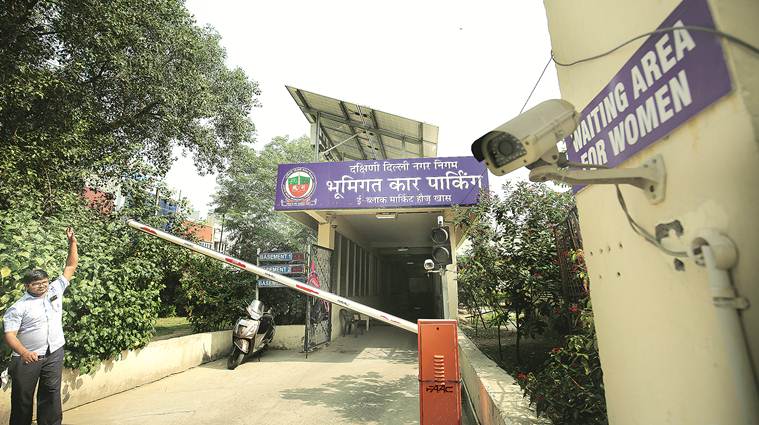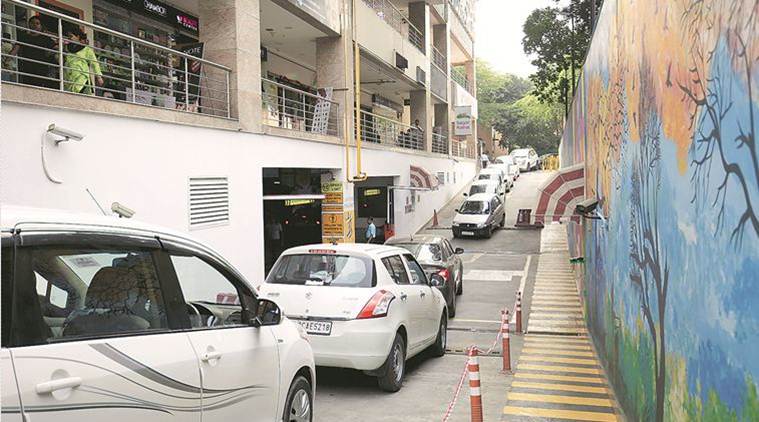 If the policy had been notified in March or April this year, as it was supposed to be, experts believe some areas would have already seen significant improvement. (Representational Image)
If the policy had been notified in March or April this year, as it was supposed to be, experts believe some areas would have already seen significant improvement. (Representational Image)
Lajpat Nagar resident Harnaam Kaur spends the whole day making sure no one parks outside their two-storey house near one of Delhi’s most popular markets. If she lets her guard down for even 30 minutes, the octogenarian, who has lived here for over 60 years, finds a car blocking her gate.
“For residents, the pressure is relentless. Throughout the day, cars of market-goers block our way. When people return from office at night, their cars fight for space. Weekends are the worst,” said Kaur.
The 83-year-old is among lakhs of city residents who have been looking to the Delhi government to implement its parking policy and ease their woes.
The policy — Delhi Maintenance and Management of Parking Rules, 2017 — is unprecedented because officials from the Delhi government, the municipal corporations, as well as civil society came together to fix the capital’s parking mess. But the bonhomie between these establishments did not last long.
Put up on the website for a month-long public consultation in January this year, the policy, which aims to discourage use of personal vehicles and surface parking, has been hanging since March. This is because of a pending decision on who will notify the policy — the Aam Aadmi Party government or the Lieutenant Governor.
Last month, the parking policy file was sent to the Delhi government’s Law Department to consider this question, in light of the fact that the Supreme Court stating that other than files pertaining to Law and Order, Land, and Police, the Delhi government has the power to legislate on all other subjects.
While Delhi Transport Minister Kailash Gahlot did not respond to calls and messages seeking a comment, a source said the file is with the law department. Gahlot is also the law minister.
The policy
Decreasing the use of private vehicles, incentivising public transport and bicycles, and making the city more pedestrian friendly — the radical parking policy has many aims. “Sixty per cent of all trips made in Delhi are short, and can easily be made on these alternative modes,” the policy states.
 Multi-level parking lot at Hauz Khas. (Express Photo by Praveen Khanna)
Multi-level parking lot at Hauz Khas. (Express Photo by Praveen Khanna)
It also makes a distinction between conventional and contemporary approach to parking in cities. While the conventional policy incentivises use of private vehicles, the contemporary one works to reduce private car usage.
“Policy planners worldwide now recognise that traditional parking policies have had unintended consequences. By and large, these have produced excess parking supply and kept the price of parking down. By reducing the cost of driving and by consuming large amounts of space, traditional policies have promoted automobile use, thus undermining public transport, walking and bicycling… newer approaches emphasise measures which manage parking demand through realistic pricing of parking, commensurate with land value and other factors, shared parking and reduced on-street requirements. Short-term parking is encouraged for efficient utilisation of land,” the policy states.
P S Jha, deputy commissioner of the South Delhi Municipal Corporation — the nodal agency of the three civic bodies for parking in Delhi — said, “Initially in the policy, there was a proposal to make even residential parking chargeable, but we realised that will lead to chaos with outsiders coming in to park. In commercial spaces, the main aim is to discourage long-term parking.”
 Multi-level parking lot at Sarojini Nagar. (Express Photo by Praveen Khanna)
Multi-level parking lot at Sarojini Nagar. (Express Photo by Praveen Khanna)
Research shows there are benefits in encouraging short-term parking, especially on the surface.
The Central Road Research Institute’s 2005 study said that of the 8,760 hours in a year, an average car’s time on the road is only 400 hours — a little over one hour a day. In cities with high traffic volume, this might go up to about two hours.
It’s at parking spaces, more than roads, where cars spend most of their time. According to the parking policy, a car occupies an average of three different parking locations every day. “Delhi, in other words, allots more public land per day for parking of cars than it does to house its poor. And all this for only 20% of the city’s population which have a family car, based on figures of the 2008 Household Survey by the Department of Transport, GNCTD,” the policy states.
Delhi has around 1 crore registered vehicles, including two-wheelers and commercial vehicles. Parking lots of the South and North MCDs can accommodate 25,000 cars each, while those in the East have space for around 17,000.
In commercial markets across the city, significant parts of open surface parking lots are used by those who own shops in the area. “These cars are parked before the market opens and leave after it is shut. They occupy the same space every day. It is the worst sort of example for contemporary parking solutions. Long-term parking should be disincentivised. If not that, they should be forced to park in multi-level parking lots. Giving them the space where a user will be in and out in a few minutes is sheer wastage. A contemporary approach will also generate more revenue for the municipal corporations,” said a senior MCD officer who did not wish to be named.
The next step, according to Jha, is to create parking area management plans for each area and residential colony. “We have to start with counting the number of cars in the area and work on providing parking space in a manner that discourages long-term halts. In areas where cabs stop frequently, for example, a transit parking should be built.”
Fate of multi-level parking lots
Multi-level parking lots at Sarojini Nagar and Hauz Khas were supposed to be the two examples of how a congested area could be transformed. Yet, both have become warning signs. According to the parking policy, there are lessons to be learnt from both. The Indian Express visited both lots and spoke to the people who operate them and use them, as well as those who don’t.
SAROJINI NAGAR MARKET
Capacity: 824
Average occupancy (through the day) Weekday: 350; Weekend: 500
The New Delhi Municipal Council’s seven-level automated parking lot with hydraulic lifts in Sarojini Nagar has a very simple structural problem. With a capacity for 824 vehicles, it has only eight pallets on which cars are moved across levels and parking spaces.
According to a security official at the lot, which began operating in 2011, an average of 350 cars enter and leave the lot on weekdays. The number touches 500 on weekends and holidays.
Despite its low parking charge of Rs 13 per hour, security and no dearth of parking space, the lot is running below capacity. According to the security official, the primary reason is that queues form because of the limited number of pallets. “At any given time, only eight cars can be moved by pallets… So, drivers frequently have to wait for their turn to park. When traffic picks up, they might have to wait for around 20-25 minutes for their turn and tempers begin to flare. Valets have been abused and even hit by impatient drivers,” the official said.
At the surface parking lot in Sarojini Nagar market, where parking charges are Rs 20 per hour for cars and Rs 10 per hour for two-wheelers, Ramesh Rajat, a parking attendant, said it is difficult for him to get drivers to go to the multi-level lot. “By noon, the surface parking spaces are used up by shopkeepers, so there is no place for customers. If shopkeepers would use that lot, everything would be easier,” he said.
However, Krishan Pal, a garment store owner, said shopkeepers are unwilling to do so as they already have a system in place. “We are not being given monthly passes for the multi-level lot and have to pay per hour. It is also time-consuming and makes our cars inaccessible if we need to use them for quick errands. On the other hand, we have been paying a monthly charge to park outside our shops for many years now,” he said.
Given the recognised limitations of the hydraulic lift system, when asked if there have been modifications to the system over the years, the security official said there have not been any changes. “The question of innovation would arise only if this was being used to its optimum capacity,” he said.
A report by the Environment Pollution (Prevention and Control) Authority on the functionality of the lot, published in 2012, had also flagged the problem: “The newly built Sarojini Nagar multi-level structure is completely electronic. There are no ramps or staircases as fallback in case of power failure or an emergency. Such projects would perhaps work near commercial and offices, where people park their cars once and retrieve it only in the evening. In markets, there is high turnover rate. During peak hours, long queues outside the structure increase waiting time.”
HAUZ KHAS MARKET
Capacity: 300
Average occupancy (through the day) Weekday: 60; Weekend: 8-10
Only one of the three levels is ever used at the underground parking lot in Hauz Khas. Opened in 2015, the 300-capacity lot sees 50-60 cars enter and leave every day, said parking attendants. “On weekends, the number of cars barely touches 10,” said an attendant.
The parking lot, which charges Rs 30 per hour, provides monthly passes for Rs 2,000. However, as of October 18, there were only 60 people availing the pass, a parking supervisor said.
Two bamboo poles form a cross, blocking the entry to the ramp leading to the lower level of the lot. “We have kept it shut because the lower levels have never been used. There is also a lift for drivers; that too is never used,” said the supervisor.
According to the attendants, the few cars parked here belong to office-goers who work nearby, and a handful of shopkeepers. Most shopkeepers and customers don’t use the lot.
K G Khanna, a shopkeeper who has been in the market since 1962, said this is because of the nature of the area. “This is a local neighbourhood market. Most customers who come here just need to park their cars for five minutes to pick up a loaf of bread or medicine. They obviously won’t go through the process of underground parking for that. Shopkeepers don’t use it because of parking charges. We park our cars outside our shops, where we don’t have to pay. The SDMC has tried to charge us for this, but we have resisted,” he said.
The parking policy had raised similar concerns: “The Hauz Khas market is essentially a neighbourhood market having a Mother Dairy booth, vegetable vendors, grocery stores and medicine shops. The market is not comparable to any big market that can attract shoppers from far-off areas. The average shopping time here is less than an hour and, therefore, the construction of multi-level parking at that place is debatable.”
If the policy had been notified in March or April this year, as it was supposed to be, experts believe some areas would have already seen significant improvement.
“At Lajpat Nagar, I had got all stakeholders together, especially RWAs and traffic police. If in one colony, for instance, there was space to park 400 cars and there were 800 cars owned by residents, it would be the RWA’s responsibility to decide which cars will be parked outside in recognised parking areas. Involvement of traffic police is key to these projects, and we were holding monthly meetings. But in the absence of a notified policy, motivation of officials is dipping,” Jha said.